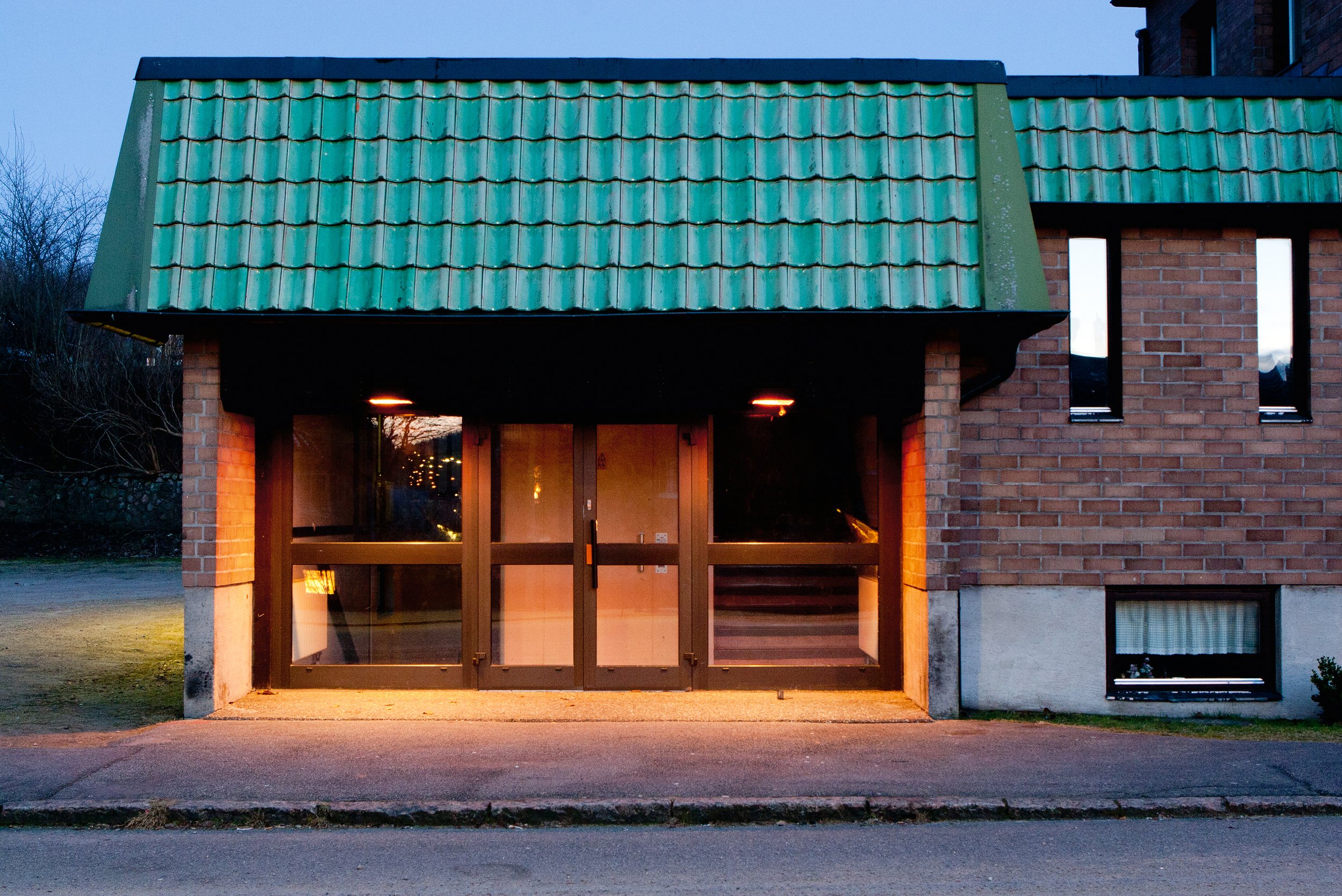FOLKETS HUS – SPACE IN COMMON
This longterm photographic project was published as a photo book by Journal in 2013 and includes an afterword by author Henrik Berggren. The large photographic exhibition has been shown in major Swedish galleries. The project is represented at Nordiska Museet Stockholm, ICP Library New York and more. It was first published by Dagens Arbete magazine in 2010. Please e-mail regarding editioned print sales, large prints can be viewed here (password: bild).
-
People's Community Centres in Sweden, Folkets Hus, are associated with both entertainment and labor. This fascinates me, the dependance between two widely separated activities with different needs of function and design, and how they share the space in the same buildings. And how some of them today not are used as much as 60 years ago.
Folkets Hus origins from the late 19th century, when the Swedish Labor Movement was opposed when attempting to have meetings. The workers then built their own meeting places – Folkets Hus. Entertainment activity partly financed the building of, and the union activity in, Folkets Hus. Labor and entertainment got dependant on each other.
I investigated the appearance that over the years has been carved out over the years by the different activities in Folkets Hus. A feeling grew that there is a sort of collective consciousness, a silent agreement on how the buildings should be designed, sprung from the functions that the buildings have in common. Also, local traditions aswell as individual creative force and pride have influenced each building.
I have photographed 66 Folkets Hus in all of Sweden’s 25 provinces, from Kiruna, north of the Polar Circle, to the the southern city Malmö. This is my personal experience of buildings that are alive in the Swedish collective consciousness, but also a Swedish cultural heritage which in some places is vanishing.
BOOK REVIEWS
Robert Bound, Monocle, UK:
"(---) Haskel's haunting work breathes such fresh and foreign air."
Kåre Bulie, D2/Dagens Næringsliv, Norway:
"(---) Om bildene hennes tematiserer kompliserte politiske og samfunnsmessige prosesser, er de samtidig utpreget farge- og formbevisste: Noen av dem nærmer seg – med sine linjer og flater – abstraksjonen. Et gammelt garderobesystem ligner en skulptur, et romdelende tekstil gir assosiasjoner til monokromt maleri. (---)"
(Translation: "If her photos thematises complicated political and societal processes, they are at the same time distincly color and shape conscious: Some of them – with their lines and surfaces – are approaching the abstraction. An old cloak room resembles a sculpture, a room dividing fabric gives associations to monochrome painting.")More press items were to be found in Fokus, Expressen, SR Kulturnytt, ETC, Arbetet, Sydsvenskan, LO-Aktuelt (Norway), Värmlands Folkblad, Helsingborgs Dagblad, Proffsfoto, Stockholms Fria Tidning, Mitt i Söderort, Västerbottenkuriren, Fotosidan, Arbetaren Zenit, Radio Sweden, Johanna Syrén photography blog, Kamera & Bild, Journalisten, Kulturen.
ARTIST’S STATEMENT IN SWEDISH
Folkets hus associeras med både arbete och nöje. Detta fascinerar mig, beroendeförhållandet mellan två så väsensskilda verksamheter med olika behov av funktion och utformning, och hur de samsas under samma tak. Samt hur vissa av dem idag inte används lika mycket som för 60 år sedan.
Folkets hus har sitt ursprung i det sena 1800-talet, då arbetarrörelsens behov av möteslokaler uppstod. Då fackföreningarna och deras försök att ha möten motarbetades, byggde arbetarna själva sina möteslokaler – Folkets hus. Nöjesverksamhet kom att delvis finansiera bygget och den fackliga verksamheten. Arbete och nöje i Folkets hus kom att bli beroende av varandra.
Jag har utforskat den stil och utseende som under åren mejslats fram av Folkets hus skilda verksamheter. Under arbetets gång har jag alltmer anat ett slags nationellt kollektivt medvetande, en tyst överenskommelse om husens utformning, sprunget ur de funktioner som husen haft och har gemensamt. Samtidigt har lokala traditioner liksom individuell skaparkraft och stolthet haft inflytande på varje enskilt Folkets hus.
Jag har fotograferat 66 Folkets hus i Sveriges samtliga 25 landskap, från Kiruna, norr om Polcirkeln, till stadsdelen Rosengård i skånska Malmö. Detta är min personliga upplevelse av byggnader som lever i vår svenska folksjäl, men också av ett svenskt kulturarv som på många håll är på väg att försvinna.
LULEÅ NYA FOLKETS HUS/RIPAN, NORRBOTTEN
DEGERHAMN/SÖDRA MÖCKLEBY FOLKETS HUS, ÖLAND
HAPARANDA TEATERFÖRENING/FOLKETS HUS, NORRBOTTEN
MALUNGS FOLKETS HUS, DALARNA
JÄRNA FOLKETS HUS/FUTURUM, SÖDERMANLAND
NILIVAARA FOLKETS HUS, LAPPLAND
MALUNGS FOLKETS HUS, DALARNA
ULLATTI FOLKETS HUS, LAPPLAND
RINKEBY FOLKETS HUS, UPPLAND
FOLKETS HUS GULLBRANDSTORP, HALLAND
FLEROHOPP FOLKETS HUS OCH PARK, SMÅLAND
"FOLKETS HUS – SPACE IN COMMON" (JOURNAL, 2013)
"FOLKETS HUS – SPACE IN COMMON" (JOURNAL, 2013)
"FOLKETS HUS – SPACE IN COMMON", GALLERI KONTRAST, STOCKHOLM 2012
SUNDSVALL FOLKETS HUS, MEDELPAD
GÄLLIVARE FOLKETS HUS, LAPPLAND
HAPARANDA TEATERFÖRENING/FOLKETS HUS, NORRBOTTEN
FOLKETS HUS KULTURHUSET TROLLHÄTTAN, VÄSTRA GÖTALAND
SKÖNSBERG-ORTVIKEN FOLKETS HUS, MEDELPAD
LÅNGEDS FOLKETS HUS, DALSLAND
MUSTADFORS FOLKETS HUS, DALSLAND
HAPARANDA TEATERFÖRENING/FOLKETS HUS, NORRBOTTEN
KIRUNA FOLKETS HUS, LAPPLAND
LILLHÄRDALS FOLKETS HUS, HÄRJEDALEN
SUNDSVALL FOLKETS HUS, MEDELPAD
STORFORS FOLKETS HUS, VÄRMLAND
MALUNGS FOLKETS HUS, DALARNA
FOLKETS HUS I OSKARSTRÖM, HALLAND
JÖSSEFORS FOLKETS HUS, VÄRMLAND




























